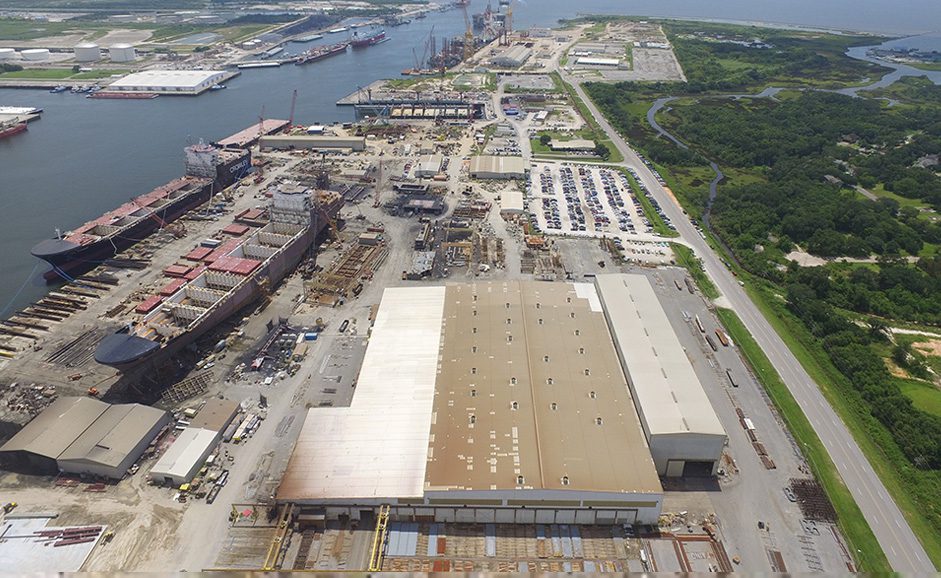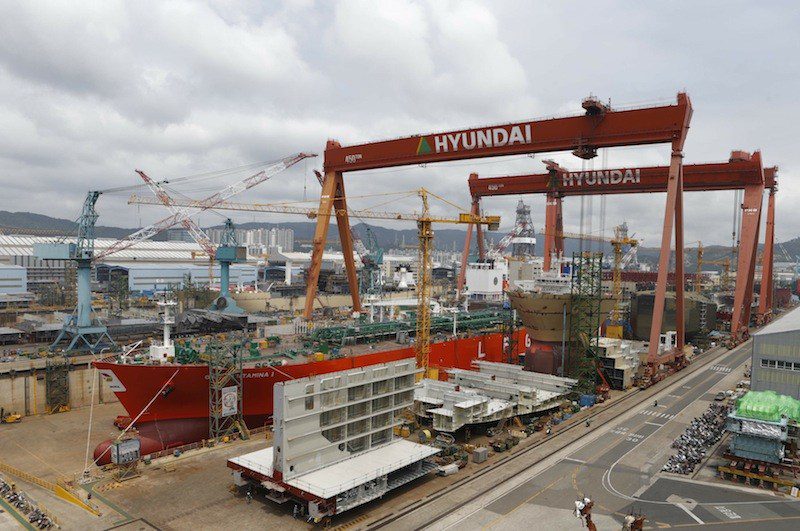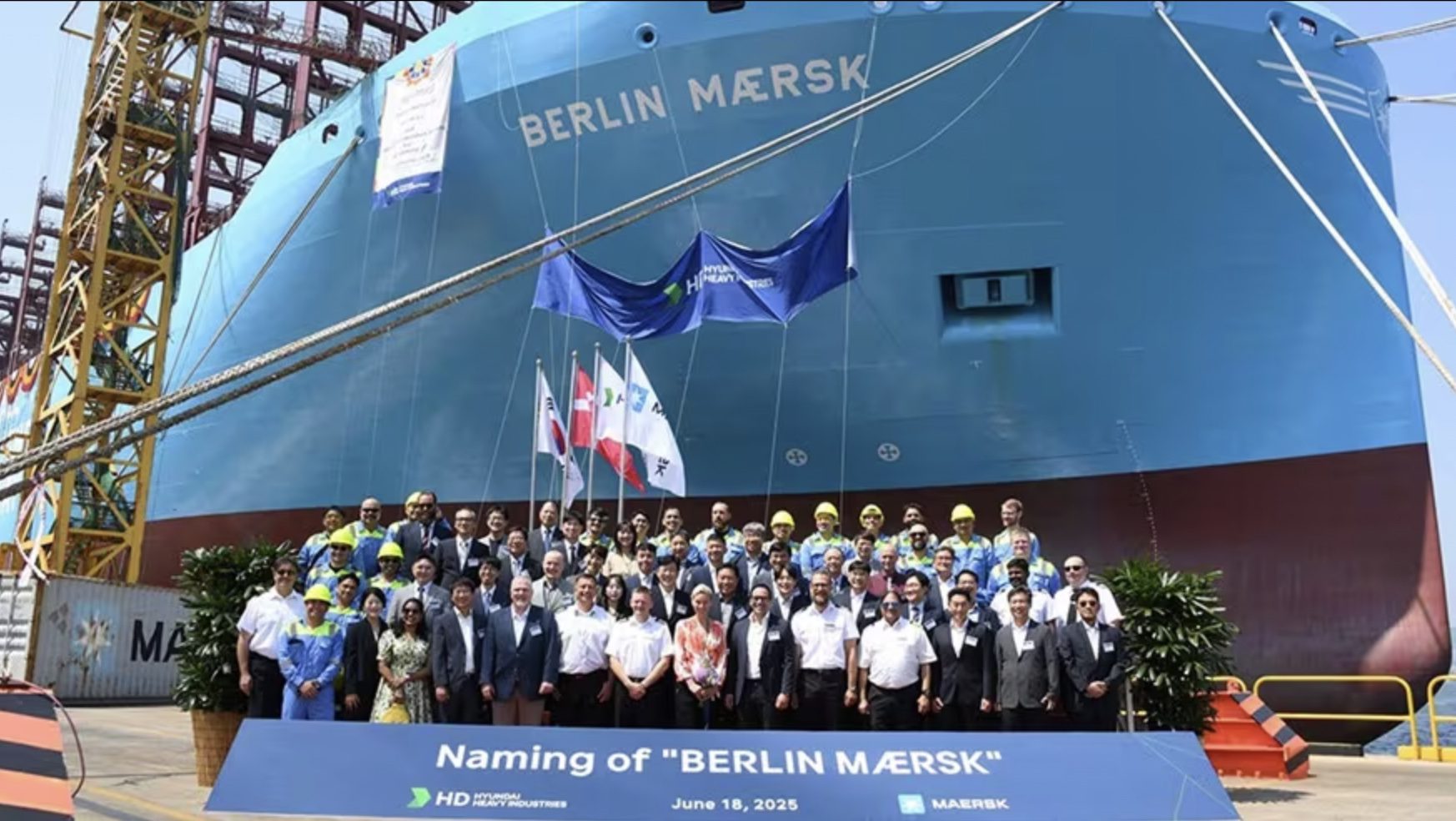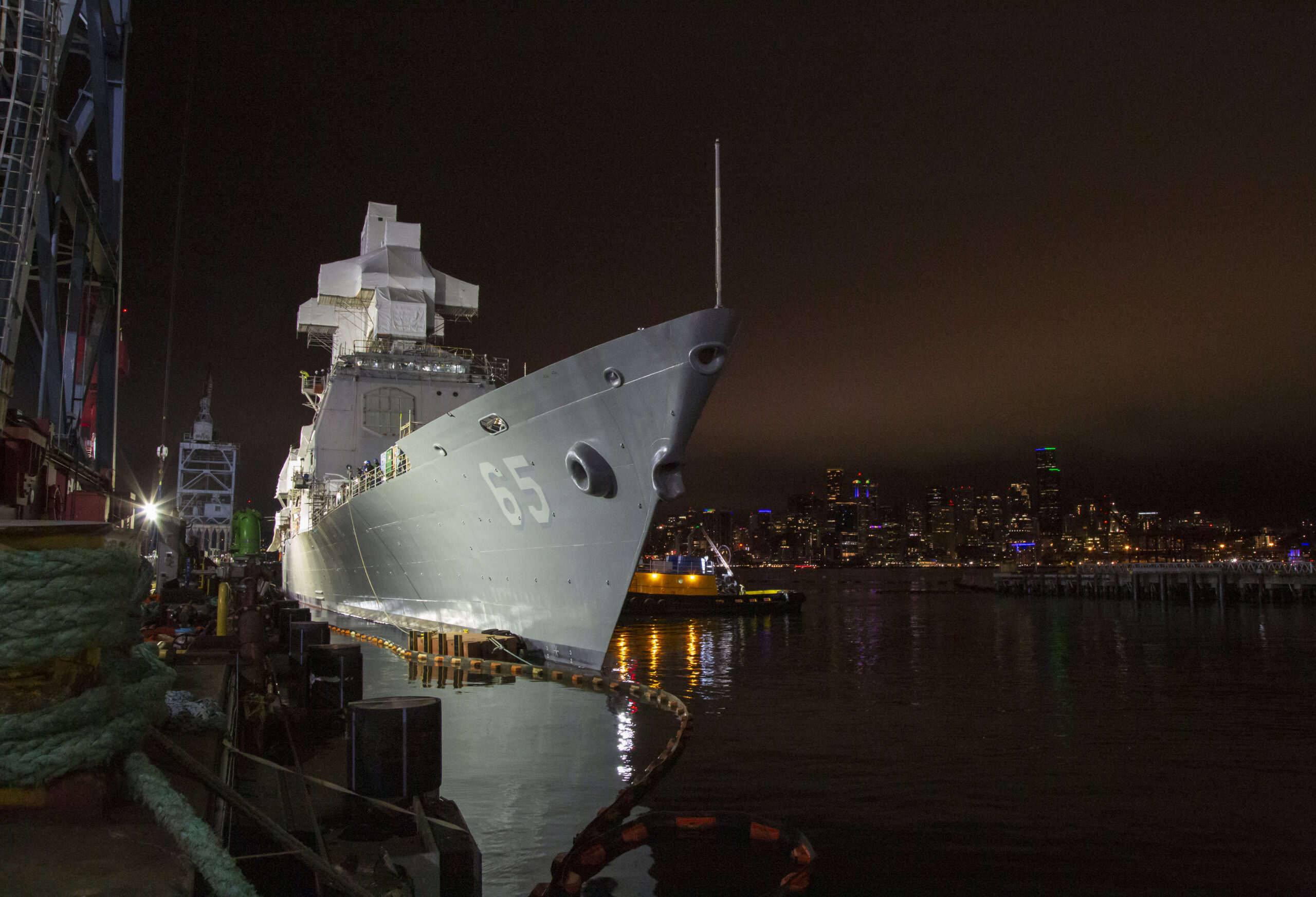With billions of dollars in new contracts, why are US shipyard valuations hitting record lows?
by Captain John Konrad (gCaptain) Yesterday Bollinger Shipyards, the largest privately-owned and operated shipbuilder in the United States, announced that it has agreed to purchase VT Halter Marine for the incredibly low price of $15 million. This is a shockingly low price for a yard with billions of dollars of government orders plus valuable facilities and real estate. Experts say the fire sale price may indicate that Halter’s contract to build the USCG’s new Heavy Icebreaker may be in serious trouble. It’s not alone. The entire US shipbuilding industry is in trouble despite growing fear the US Navy will fight a war in the Pacific and US shipyards signing record-setting contracts.
The news about Halter’s firesale, first reported by Craig Hooper at Forbes, comes as a shock to the US shipbuilding industry. The risk wrapped up in Halter Marine was too much for its Singapore-based parent company ST Engineering to absorb. The contract for the first US Coast Guard Polar Security Cutter – which would be the first heavy icebreaker is a $745.9 million fixed price, incentive-firm arrangement. In total, the shipyard was set to get about $1.94 billion if the Coast Guard exercised all three options.
“That sounds good, but it’s a very low-priced bid, and, to profit, the shipyard had to perform perfectly,” said Hooper. “Given the contract’s structure, Halter Marine—and ST Engineering—had a lot to lose if the shipyard was unable to meet the price target. With a fixed price target, even a modest 10% overage on a $2 billion construction contract is a tough pill to swallow for any parent company, no matter how big.”
Coast Guard leaders expected Halter Marine to start cutting steel this year, but the shipyard has shown no sign of getting started less than two months before the end of 2022.
ST Engineering is so motivated to get out of the deal they are willing to sell 378 acres of waterfront property – comprising 2 shipyards in Pascagoula, Mississippi, and two dormant yards north of Pascagoula – advanced manufacturing facilities, deep technical knowledge learned building complex surveillance ships and billions of dollars in defense contracts for $15m or about the price it costs to purchase a single large container handling crane built in China.
The VT Halter Marine deal was announced on Sunday, just days after the American containership company Matson awarded Halter Marine’s rival, Philly Shipyard, a billion-dollar order for three small 3,600 TEU Jones Act ships, a new record-setting price.
To put the price difference in perspective Maersk recently ordered six of the world’s most advanced methanol-powered containerships in South Korea for $1.14 billion but those ships carry 17,000 TEU containers for a per TEU price of $11,176. The simpler ships Matson is building in Philadelphia will cost an eye-watering $92,592 per TEU.
Low Profits
You might think that American shipyards, with billions of dollars in contracts and powerful protection from laws like the Jones Act, are highly profitable. The truth is, you could buy the largest shipyard in America for less than it would cost you to buy Roku and Peloton.
American shipyards have high capital costs. They need large workforces and lots of industrial infrastructures that require constant maintenance. So very little of their enormous income results in profits. The largest US shipyards have an even bigger problem, they are monopsonies (companies with only one customer), and the US Navy – notorious for change requests and work stoppages – is more interested in building aircraft and missile systems than ships.
The cost to build a ship in the United States is astounding but these prices don’t always lead to profit. The most expensive ship ever built, Gerald R. Ford class US Navy Aircraft Carrier, came with a price tag of $13.3 billion and its builder, Huntington Ingalls Industries (HII), has three more under construction with Congress wanting to purchase more. The company also has multi-billion dollar contracts to build large-deck amphibious ships, nuclear attack and ballistic missile submarines, advanced destroyers, and unmanned vessels. HII has a pipeline of over $60 billion in contracts, with more on the way. But Wall Street only values the company at $9.75 billion.
To put that in perspective, the United State’s largest and most important shipbuilder, HII, is worth:
- Less than 1/4 the price Elon Musk paid for Twitter.
- Just over 1/10th the market capitalization of Boeing
- About 1/14th the value of the largest US defense contractor Raytheon.
- Less than the combined price of Peleton and Roku after their prices burst
VT Halter – builder of the USCG’s forthcoming heavy icebreakers – is worth considerably less. Just $15 million.
Blame Aerospace
Even more troubling is comparing the value of the US defense contractors in aerospace to our shipbuilders. The top three aerospace companies that build missiles and planes for the Department of Defense – Raytheon, Lockheed Martin, and Boeing – have a combined market capitalization of over $350 billion or thirty-five times the valuation of HII.
General Dynamics (GD), the United States’ second largest shipbuilding company, is worth $68 billion but they also build Gulfstream airplanes and Abrams tanks. In fact, half of GD’s value is due to the doubling of its stock price since Covid hit in March 2020. Why has it doubled? In the first quarter of 2021, its aerospace division had an $11.9 billion order backlog, today its backlog is $19.1 billion and rising. Meanwhile, its order backlog for ships and marine systems has fallen by $7 billion over the same period.
Related book: Heavy Metal: The Hard Days and Nights of the Shipyard Workers Who Build America’s Supercarriers by Michael Fabey
What do all these numbers mean? While the price tag for ships is extremely expensive, very little of the Pentagon’s shipbuilding money is lining the pockets of defense contractors. At the same time, billions of dollars of government money have passed through aerospace defense contractors and into the pockets of wealthy investors.
In just the last three months Raytheon, which produces the Javelin anti-tank missile, returned $1.4B of cash to shareowners. That’s hundreds of millions more than Maersk paid for America’s allies in Korea to build six giant eco-friendly containerships and it’s almost as much as Bollinger agreed to build two heavy icebreakers.
In addition to congressional spending, it’s important to look at the financial markets. The large market capitalizations of aerospace companies combined with the high-profit margins and relatively tiny labor forces that are intrinsic in building relatively small aerospace weapons like Javelin missiles make them attractive to investors and banks. This significantly lowers their cost of capital and greatly increases their access to new types of coded capital. Aerospace companies get assistance from the FAA and foreign sales help from the Department of State while shipyards must look to the mostly defunct US Maritime Administration (MARAD) and their unpopular Title XI program for financial help.
Follow The Money
Yes, ships are incredibly expensive but the sad fact is that nearly every dollar of shipyard profit gets spent on American workers, American shipyard infrastructure repair, American steel, and American interests while billions of dollars of aerospace funding pass through to stockholders and executives every single quarter.
And the Navy, with its love of carriers and aviation, isn’t interested in building more ships. According to recent testimony by US Navy CNO, Admiral Gilday, the navy wants to spend more on Raytheon missiles and less on ships and is on the hook to pay its share of the $412 billion F-35 fighter plane program, but it’s also on the hook for buying new F-35’s for the Marines.
Increases in ship funding are unlikely for another reason. Under current acquisition rules funding is split evenly between the US Navy, USAir Force, and US Army yet – in addition to ships – US Naval Aviation must help the US Air Force pay for development aircraft like the F-35, the US Marine Corps must pay for joint development of land assets like the Javelin missile, and US Navy jointly developed air defense missiles with both. As a result, a huge portion of the Navy’s 1/3rd of the DoD budget is spent on aircraft and air-launched missiles.
The Navy also must shoulder the cost of transportation. By volume, the large majority of equipment and fuel the Pentagon moves overseas moved is done via ship. Many of those vessels are part of the US Navy’s large fleet of expensive Military Sealift Command ships.
(The US Air Force also spends a lot on transportation but the combined fleet of all US Air Force transport aircraft can carry less than one large Maersk containership and burn hundreds of times the fuel. Fuel that often must be supplied by US Merchant Marine tankers.)
A fair allotment of the cost would have the US Air Force paying for planes and the Army funding Marine land assets and surface-to-air missile technology. But that’s not likely to happen for three major reasons:
- The services fight each other for every penny
- The US Naval Aviation community is influential does not want to surrender any control to the Air Force
- A healthy percentage of enormous DoD aerospace profits are rolled into lobby efforts.
- The US Navy has a low level of financial acumen and does not understand modern capital asset coding
- The Secretary of Defense and Joint Chiefs Of Staff are Army Generals unfamiliar with shipbuilding
The US Air Force has long been a powerhouse in lobby efforts and financial engineering but now the Army has replaced them in the top spot. The US Army holds the most important Pentagon leadership roles and has built an enormous amount of power over the last two decades of the Global War on Terror. The $8 trillion dollar cost of two decades of land battles has benefited the Army most and now that we are pivoting towards the Pacific maritime domain, it’s unlikely the Army will be willing to let go of control.
It’s difficult to measure the true influence the US Army has over budgeting today but one simple observation makes this clear. gCaptain attended the largest US Navy event early this year, Sea-Air-Space Expo 2022, and rooms were available at the hotel that hosted the conference. During the US Army’s equivalent conference last month – AUSA 2022 – every hotel in all of Washington DC was filled to capacity. This is an enormous amount of momentum for shipbuilders to overcome.
The Future
War on Ukraine has reiterated the importance of logistics in battle and most logistics are still moved by sea yet the majority of the United States Merchant Marine’s ready reserve fleet is not ready for war. The result of the test of sealift logistics in 2019 netted a 40.7% cumulative fleet success rate. This might be ok in a Middle East land war but in the vast expanse of the Pacific, ships matter most.
Some believe that aircraft can take the place of ships. That has been the case since the Battle of Midway in 1942 but times are changing and climate goals have become a top Pentagon priority. The US Air Force is the world’s biggest consumer of oil. Ships are 400% more energy efficient than planes and the carbon reduction efforts of the Biden administration are pushing for fuel reduction solutions and replacing lots of planes with a smaller number of much more capable warships is the single best war to meet climate goals.
Hardcore military planners might balk at the idea of giving up aviation capacity for increased naval capability in the Pacific just to meet a climate goal. But there are real military reasons for reducing the Pentagon’s dependence on fuel. The cyber attacks on the Colonial Pipeline and physical attacks on Nord Stream have proved that fixed pipelines are highly vulnerable to attack. The only other option for moving vast quantities of fuel to remote Pacific airbases is slow commercial oil tankers.
Related book: Heavy Metal: The Hard Days and Nights of the Shipyard Workers Who Build America’s Supercarriers by Michael Fabey
War in Ukraine has taught us one more important lesson… that Ukraine can fight Russia without any air superiority at all.
In the meantime, let’s hope the US Army never needs to fight a battle in the Arctic. If they do, getting fuel or supplies to troops will be difficult considering the US Military’s only heavy icebreaker project run by Halter Marine is likely in very big trouble indeed.

 Join The Club
Join The Club











